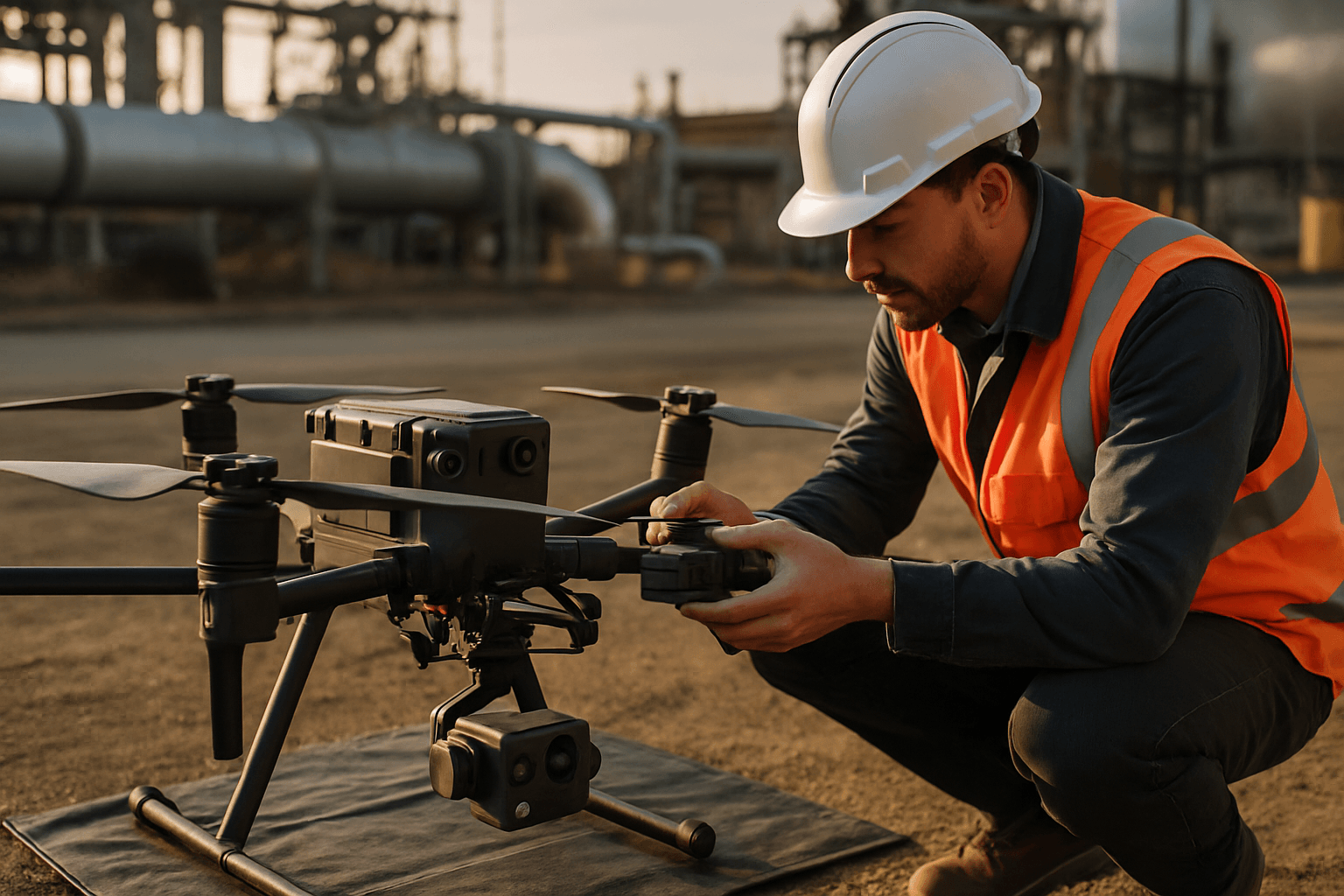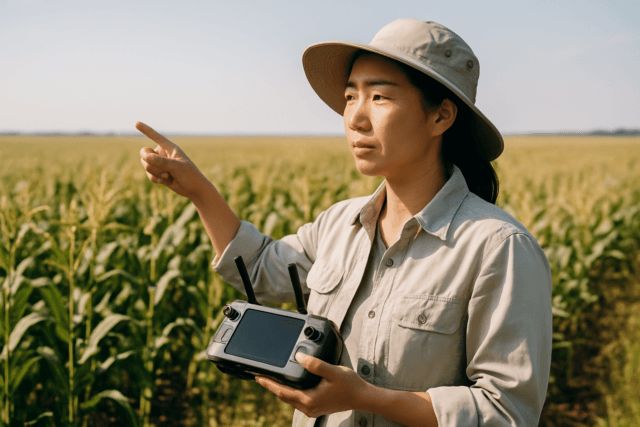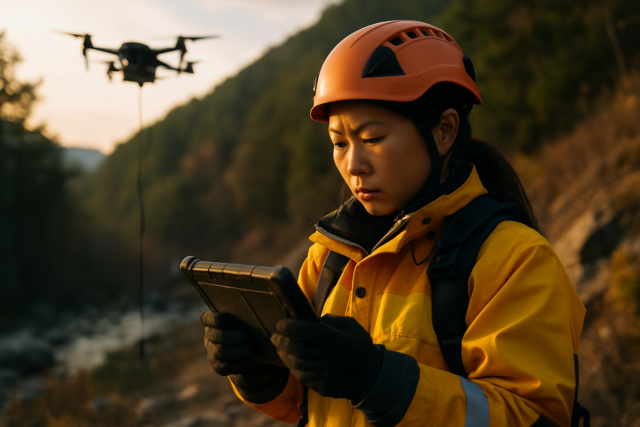Drones, once primarily associated with military and recreational use, have rapidly emerged as powerful tools for businesses across various sectors. Their ability to gather data remotely, conduct inspections, and automate tasks offers a compelling case for cost savings compared to traditional methods. This article explores the myriad ways in which drones provide financial benefits, examining real-world examples and industry insights to provide a comprehensive understanding of their economic advantages.
Industries Benefiting from Drone Technology
Drones are versatile and create cost efficiencies across industries such as:
- Construction: Drones streamline site surveys, monitor progress, manage resources, and inspect equipment, reducing downtime and improving accuracy.
- Agriculture: Drones enhance crop management through land mapping, precision farming, agrochemical spraying, and crop assessment.
- Infrastructure Inspection: Drones safely inspect bridges, power lines, and pipelines, reducing downtime and maintenance costs.
- Security: Drones offer cost-effective and comprehensive surveillance for corporate campuses and other facilities, reducing the need for extensive personnel and infrastructure.
- Delivery: Drones provide faster and more reliable last-mile delivery, especially in areas that are difficult to reach with traditional methods, potentially reducing costs by up to 70%.
- Emergency Services: Drones assist in search and rescue operations, conduct patrols, and act as first responders, offering significant cost savings compared to helicopters and traditional methods.
- Surveying and Mapping: Drones conduct land surveys and terrain mapping faster and more affordably than traditional methods, reducing downtime and preventing costly rework.
Direct Cost Reductions with Drones
Drones cut costs in several key areas:
- Reduced Labor Costs: Drones require smaller teams to operate compared to traditional methods that involve large crews. For example, drone surveys can be conducted by a small team of pilots and data analysts, reducing the need for extensive manpower.
- Elimination of Scaffolding and Rope Access: For inspections of high-rise buildings or infrastructure, drones eliminate the need for expensive scaffolding or rope access teams. This can result in substantial savings, as exemplified by a project in Sheffield where drones saved £30,000 in scaffolding and inspection costs.
- Lower Equipment Costs: Drones can replace specialized inspection tools and reduce the need for heavy machinery, resulting in significant savings.
- Decreased Downtime: Quick data collection and real-time monitoring reduce project downtime. A RICS report indicated that drone deployment could reduce large-project site downtime by up to 40%.
- Efficient Resource Management: Drones enable real-time tracking of materials, equipment, and inventory on construction sites, ensuring efficient resource allocation and reducing wastage.
Enhanced Operational Efficiency
Drones enhance operational efficiency through:
- Improved Accuracy: High-resolution cameras and sensors capture precise data, reducing errors and rework. A 5% quantity variance can be observed between traditional survey methods and drone surveys, with drones providing more accurate results and reducing discrepancies.
- Better Decision-Making: Accurate and timely data enables informed decision-making, optimizing processes and minimizing risks.
- Increased Safety: Drones can access hazardous or difficult-to-reach areas, reducing risks to human workers. This leads to fewer accidents, lower insurance premiums, and reduced injury-related costs.
Real-World Cost Savings Examples
Several case studies highlight the significant cost savings achieved through drone integration:
- Construction Site Surveying: Barratt Developments cut £20,000 in labor costs by using drones for housing site surveys.
- Police Air Service Operations: Shifting police air service operations to drones resulted in a 55.4% cost reduction, saving approximately £22.6 million per year.
- Maritime and Coastguard Agency: The Maritime and Coastguard Agency estimates roughly £1.6 million per year in operating costs saved by using drones for search-and-rescue and patrols.
- Security Services: Titan Protection, a security company, reduced security costs by 60% by implementing autonomous drone technology, leading to a complete ROI within 12-18 months for clients.
- Commercial Office Renovation: A major commercial developer used construction drones to monitor the renovation of a 20-story office building, reducing inspection time by over 60% and labor costs by nearly 30%. The drone-generated 3D models enabled early detection of structural issues, preventing costly delays and contributing to a 25% overall improvement in project ROI.
- Highway Infrastructure Project: In a state highway construction project, drones were used for routine progress tracking and safety inspections. The aerial footage helped the project team detect hazards early, resulting in a 40% reduction in safety incidents. Additionally, the high-resolution maps enabled better logistics planning, reducing material delivery times and shortening the overall project timeline by 15%.
- Offshore Wind Farm Inspection: A 2021 ScienceDirect study found that using drones to inspect an offshore wind farm resulted in 70% cost savings compared to traditional rope access inspections. The time savings from using drones also decreased downtime losses by 90%.
- Chemical Plant Inspection: Voliro T drone technology enabled completion of an inspection in just 2.75 days—substantially less than the 8 days typically required with conventional rope access methods. The drone’s deployment not only slashed inspection time but also reduced the required crew size from at least three individuals to just two, further driving down operational costs. As a result, Bilfinger delivered a 30% cost reduction to their client.
- Coffee Production in Brazil: Using drones to apply pesticides, fungicides, and foliar fertilizers has reduced operational costs for Brazilian coffee growers by 70% compared to manual spraying and 50% compared to tractor spraying.
- Vineyard Management in Romania: An elderly vineyard owner using a drone was able to reduce chemical usage by half, from 241.64 liters to 111.94 liters, and the time required for spraying was reduced from 3-4 days to just one day.
Drones in Construction: Optimizing Budgets and Timelines
Construction is an industry that requires a lot of capital. Building something requires tools, labor, planning, monitoring, and investments. It is a complicated industry, but staying under budget is a must. With so many different factors at play, this can be a serious struggle for project managers. Managing a budget and a timeline is an extremely difficult task, but there is a technology that many construction companies are adapting to save money: drones for construction use. There are many practical uses for drones in construction. These unmanned aircraft offer high-quality video and photo-taking capabilities that provide key information for those who know how to use them correctly. With several different applications, construction drone videography and photography can save you a lot of money.
Increased Worker Safety
According to the Department of Labor, there were 1,102 work-related fatalities in the construction industry in 2019. Drones in construction safety can make a big difference. As every construction company knows, your workers are your most important asset. The hard work they do is how jobs get done, and any measure that could be taken to protect them should be taken, considering construction is an industry that presents risks.
Drones in construction play a big role in protecting these workers, which keeps morale high and projects on schedule, cutting the risk of human and financial costs that come from injury. Drones for construction can increase worker safety by fulfilling potentially risky roles that workers would’ve in the past. Construction drone photography can survey things like roofs or high areas of buildings that are hazardous, presenting high-quality images that provide useful information. Drones also allow supervisors and safety managers to monitor the site, checking for potential dangers and identifying risky situations before they happen.
Saving Time
When it comes to construction, time is money. Every business wants to optimize and work quickly. Drones can make construction much faster. Drones in construction can assist in simplifying land surveying, which can typically be a tedious process. The same can be said for estimates. Drones can drastically reduce the time spent on these tasks, saving money and optimizing workflow. Drones are also capable of performing regular inspections much faster, which gives managers the ability to adjust and improve the project as it goes on.
Simplified Land Surveying
Traditional land surveying is a task that often requires a large team to spend a lot of time on location. Drones simplify land surveying. As drones capture aerial shots of land and measure at a high level, they can complete land surveys within hours instead of weeks. Not only will this save money on labor costs, but it will also allow for more accurate measurements and simplify the process.
Estimates Made Easy
A big aspect of construction is giving accurate estimates to customers. However, before drones, this task was more tedious than it is today. With drones in the construction industry, “free” estimates are revolutionized. A drone can do this job much quicker, freeing up time for workers, and saving money for your business. Construction drone photography will capture aerial shots for the estimates, mapping out land, and providing high-quality photos for reference. Drones are also more capable of providing key information as their cameras capture measurements extremely effectively, reducing human error. This leads to more accurate estimates, ensuring more profitable jobs.
Effective Marketing Tools
If your business is going to succeed, you need to stand out from competitors. There are a million different pathways companies can take when it comes to marketing, but one of the best benefits of drones in construction is that they provide high-quality marketing content at a modest cost. Construction drone footage is typically in 4K ultra HD quality, provides aerial shots of construction sites and surrounding areas, and captures angles that no other method can.
Drones in Agriculture: Revolutionizing Farming Practices
As global food demand soars, American farmers face an unprecedented convergence of challenges—rising costs, resource limitations, labor shortages, and increasingly unpredictable weather. As a result, drone technology has emerged as a game-changer, revolutionizing how farms operate by driving efficiency, sustainability, and resilience. With the U.S. agricultural sector contributing over $1.530 trillion, or 5%, of the national GDP, drones can play a pivotal role in safeguarding this vital industry.
Precision and Efficiency
Drone technology can empower farmers with faster, more precise ways to manage their fields. Compared to traditional equipment such as rigs, ground sprayers, or small airplanes, drones offer superior precision. They can spray herbicides, pesticides and fertilizers with accuracy, reducing waste and ensuring that only targeted areas are treated. This level of precision also enables drones to plant cover crops, such as cereal rye, helping farmers maximize land use with minimal disruption to soil. But what truly sets drones apart is their ability to survey vast farmland quickly and provide real-time insights.
Cost and Resource Savings
By minimizing the need for expensive machinery and limiting reliance on manned aircraft, drones offer farmers a cost-effective alternative for many tasks. Agricultural drones have treated over 500 million hectares globally, yielding cumulative savings of 210 million metric tons of water—equivalent to the annual water consumption of 390 million people. Furthermore, agricultural drone use has reduced chemical usage by 47,000 metric tons and lowered carbon emissions by 25.72 million metric tons—equal to the annual carbon sequestration of 1.2 billion trees.
Early Intervention
With infrared cameras, drones can swiftly identify signs of crop stress—whether from drought, pests, or disease—allowing farmers to make early interventions with precision irrigation or pesticides.
Financial Benefits
The financial benefits of drone technology in agriculture extend beyond cost savings. By improving efficiency and reducing expenses, drones enhance the overall financial health of farming operations, making them a wise investment for the future.
Drones in Security: Enhancing Protection and Reducing Costs
Unmanned aerial vehicles are now finding increased application in the security sector. In the coming years, more and more businesses are going to deploy AI-based drone security systems to improve perimeter protection and situational awareness at their facilities and minimize health and safety risks to human guards. Due to their unique capabilities, drones integrated with AI solutions assist on-site security officers in their tedious and dangerous missions, allowing them to focus on decision-making. Additionally, they help reduce operational costs and make physical security cost-effective for businesses of all sizes.
Rapid Response
Emergencies require immediate action because every minute can be a difference between life and death. With security drones, the process is much more effective. A drone for surveillance can perform perimeter patrols 30 times faster than a manned patrol, so it provides feedback in a few minutes.
Improved Visual Capacities
Surveillance UAVs can fly from a high altitude that allows offering a wide aerial viewpoint without blind spots. With high-quality sensors and HD cameras, drones can detect anomalies or events in low light conditions and from meters away.
Safe Missions
By using remotely controlled drones, you can help reduce the risk to security staff as pilots will be a safe distance away. In the event of a suspect apprehension or disaster outbreak, it is best to send a drone to see the situation first and investigate potential risks before humans get inside.
Cost Savings & Increased ROI
While the initial investment in drone technology will be expensive, the long-term benefits far outweigh the initial cost in terms of return on investment. The cost of a security drone is only 20% of traditional security officer coverage.





